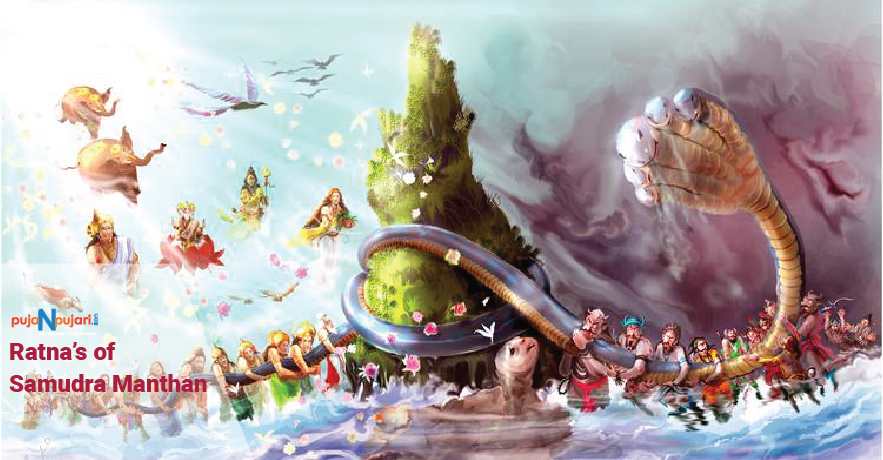Hindu Purana Stories
Samudra Manthan 14 Ratnas List Items
As the churning progressed, the Kshreea Sagara, with the herbs' effects induced into it, started producing various Ratna's. As agreed upon earlier, these Ratna's were divided 4 ways among Lord Vishnu, Lord Shiva, Devas, and Asuras.
[Note: Various Puranas mention a different number of Ratna's produced from the ocean's churning. The number ranges from nine to fourteen. We are covering all of them in this blog to mention the complete list.]Following is the order in which the Ratna's emerged.
- Chandra
- Parijata
- Airavata
- Kamadhenu
- Madira or Varuni, the goddess of wine
- Kalpavriksha
- The Apsaras
- Uccaihshravas
- Goddess Lakshmi
- Panchajanya
- Vishnu's mace and magic bow
- various gems like Kausthubha and Chintamani
- Dhanvantari
- The Amrita
We can categorise these Ratna's to understand their importance.
Three categories of Goddesses are
Lakshmi: Goddess Lakshmi is the divine consort of Lord Vishnu. She forms the trinity of Goddess along with Goddess Parvathi and Goddess Saraswathi. She is also the goddess of good fortune and wealth. Since Lord Vishnu is the protector of the realm, goddess Lakshmi chose him as her husband to bless the realms with god fortune when it deserved.
Apsaras: Apsaras chose Gandharvas as their consorts since they had good compatibility, as they were blessed with fine art for singing and dancing. Among the apsaras, Rambha, Urvashi, Menaka, and Tilottama were really popular for their mastery over the arts and took refuge in the court of Indra at devaloka.
Varuni or Madira: Madira is the goddess of Wine. Though she appeared dishevelled, she was taken by the Asuras for the taste of the intoxicating drink she was able to prepare. Other sources mention her as the daughter of Lord Varuna.
Like, three goddesses, three supernatural animals appeared during the Amrit Manthan.
Kamadhenu: Kamadhenu was the wish-granting cow. One had to make a wish in front of Kamadhenu, and it would be immediately fulfilled. Kamadhenu was taken by Lord Vishnu and handed over to the sages to get milk and its products like Ghee for performing yajnas.
Airavata: Airavata is also known as the Elephant of clouds and is said to possess 4 trunks. The Airavat and the elephants that emerged with it were taken by Indra. The elephant is said to be the protector of the directions and is also said to connect both earth and sky, thus being one of the pillars to complete the water cycle.
Uchhaishravas: Uchhaishravas is the seven-headed horse and was given to Bali as a part of a sharing contract. Snow-white in colour, the Uchhaishravas is said to be the king of horses. Though small, the role Uchhaishravas plays in a bet between two sisters Kadru and Vinata forms the crux of the life story of Garuda.
The next classification is the Gems.
There were three valuable Gems produced during the Amrit Manthan.
Kaustubha: One of the most divine and the most precious gems is Kausthubha. The crystal clear gems reside on the chest of Lord Vishnu. It is said that Goddess Lakshmi, who resides in the Lord Vishnu's heart, uses the gems to look at her reflection.
Parijata: The tree that produces never-withering and the most fragmented flowers is the Parijatha was taken by Lord Indra to devaloka. In the later stories, it is said that Krishna, on the behest of Rukmini Satyabhama, fought with Indra and brought it to bhuloka. Since Indra could not curse Krishna as he was the incarnation of Vishu, he cursed the parijatha tree saying – Let the flowers wither as soon as it falls from the tree and let it have a short life. Few other Puranas mention Kalpavrikha as the tree that came out instead of Parijata.
Sharanga: Crafted by the master weapon maker Vishwakarma, Sharanga the mighties bow came out of Sagara Manthana. The bow is said to be even more powerful than the shiva's bow – Pinaka.
The other three Ratna's that emerged were –
Chandra: Shiva decided to take Chandra (or the moon), and he adorned Chandra on his head, which earned him the name Chandrashekhar. Thus just one episode of manthana gave three names to Lord Shiva, depicting various phases of the process.
Dhanvantari and Amrita: The last product to come out of the Manthana was Dhanvantari holding the pot of Amrita in his hand. Dhanwantari is the most accomplished healer of the devas. According to some texts, he is said to be the father of Ayurveda. Amrita is the nectar that restores the power and grants immortality to the person consuming it in the prescribed portion.
Other scriptures mention other Ratna's to make up for the numbers instead of those mentioned here. They are Panchajanya – Shanka of Lord Vishnu, Earrings – which Indra gifted to Aditi, a divine umbrella which was taken by Varuna, Nidra Devi – goddess of sleep, and Jyeshta – Goddess of misfortune.
Thus, the churning produced various precious items and was divided between people taking part in the humongous task.
Also Read
PART 1: Samudra Manthanam Story From Vishnu Purana & Shiv Purana
PART 2: Preparations for the Ksheerasagara Manthan or Churning of the Ocean
PART 3: The Story of Shiva Drinking Poison/Halahala
PART 5: Lord Vishnu’s Mohini Avatar



Good insight on different types of gems
Learned valuable information regarding sanatan religion.
Poresh Das
Thank You so much stay tune for new blogs
Excellent
very informative. Any other relevant article to read?
Thank You so much,
here is the some interesting articles.
https://www.pujanpujari.com/maha-kumbh-mela-2023-dates-significance-importance-history-place-and-imapact/
https://www.pujanpujari.com/what-happens-when-guru-mahadasha-starts-and-ends/